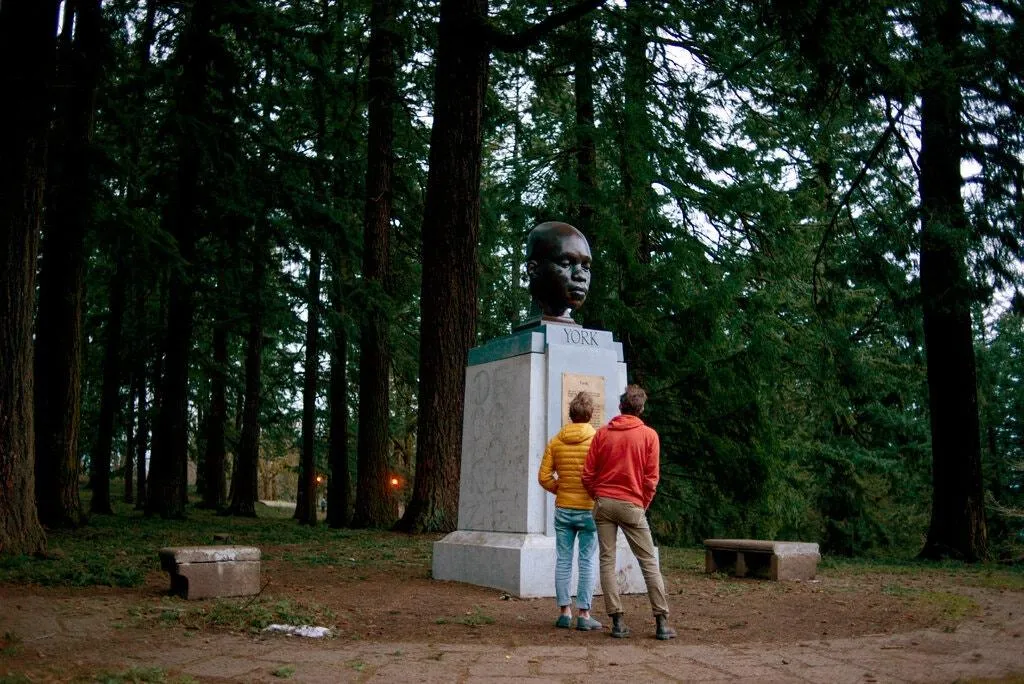Anonymous Artist Installs Bust of York, Enslaved Explorer Who Accompanied Lewis and Clark, in Portland Park
The monument replaces a statue of conservative editor Harvey Scott that was toppled last October
:focal(458x336:459x337)/https://tf-cmsv2-smithsonianmag-media.s3.amazonaws.com/filer/17/1a/171ab2b1-2e1a-4ec8-a0ac-e1f4fc661858/york_bust.jpg)
This past weekend, an anonymous guerrilla artist surreptitiously installed a monument honoring York, a black man who accompanied Lewis and Clark on their famed 1804 expedition, at Mount Tabor Park in Portland, Oregon.
An inscription below the larger-than-life bust, which appears to be made out of cast bronze, identifies York as “the first African American to cross North America and reach the Pacific Coast,” reports Kristian Foden-Vencil for Oregon Public Broadcasting (OPB).
The text explains that “though York was an enslaved laborer, he performed all the duties of a full member of the expedition. He was a skilled hunter, negotiated trade with Native American communities and tended to the sick. Upon his return east with the Corps of Discovery, York asked for his freedom. Clark refused his request.”
Speaking with Artnet News’ Sarah Cascone, the monument’s creator, who is identified only as a white man, says, “I want to stay anonymous to keep the conversation about the subject.”
He adds, “[The statue] pays homage to York at a time when we all need to remember the important role that African Americans have played in our history and reflect on the tragedy of slavery—a tragedy that continues to echo.”
The pedestal where the artist placed York’s bust previously held a memorial to 19th-century conservative newspaper editor Harvey Scott, who used his platform to oppose such social reforms as women’s suffrage, according to the Oregon History Project.
Activists pulled down the monument last October as part of a wave of statue topplings sparked by racial justice protests. As Jim Ryan reported for the Oregonian at the time, no one took credit for tearing the statue down, and the city subsequently moved the public work into storage while debating its fate.
Because no depictions of York made during his lifetime exist, the artist relied on research by Charles Neal, who led efforts to install a memorial to York at Portland’s Lewis and Clark Law School. Neal had tentatively traced York’s family origins to Ghana, so the artist modeled the work on a friend whose own family came from that part of Africa.
Once the bust was finished, the sculptor fitted it with a base designed to fit on the pedestal without drilling, enabling him and a small team to install it quickly in the middle of the night.

Like his parents, York was enslaved by the father of famed explorer William Clark. The two grew up together, and the elder Clark left York to his son in his will. Though Clark and Meriwether Lewis brought York on their expedition as an enslaved “body servant,” he played a similar role to the party’s other members, including voting on various decisions, as Shoshi Parks wrote for Smithsonian magazine in 2018.
York was one of two men sent on a mission to bargain with the Nez Perce, winning the hospitality the group needed to continue on its way. But Clark also demanded that he use his appearance to intimidate the Native Americans—an effort that, by one Nez Perce account, convinced them not to attempt to kill the whole group.
After returning from the western United States, Clark refused to free York and, in fact, eventually hired him out to a Kentucky farm owner known for abusing enslaved laborers. Scholars have little definitive information about the remainder of York’s life, but he was apparently freed sometime between 1811 and 1815. Per PBS, York reportedly died of cholera sometime before 1832.
Despite the unauthorized installation of the monument, City Commissioner Carmen Rubio says in a statement that Portland officials will keep it in place “for the foreseeable future.”
Rubio adds that the city will also work with artists of color to make monuments displayed in its parks more racially inclusive.
“This is what we’re calling guerrilla public art, but it was a pleasant surprise,” Adena Long, director of Portland Parks & Recreation, tells the New York Times’ Alan Yuhas.
Kerry Tymchuk, executive director of the Oregon Historical Society, questions the lack of a formal process around the decision to let the memorial remain in place.
“It can’t just be free game for anybody to take a statue down or put a statue up—it’s an invitation for chaos,” he tells the Times. “What if they had put somebody else up besides York?”
Long, for her part, says officials will continue to consider installations on a case-by-case basis.
The artist tells Artnet News that he’s happy with the reception his work has received so far.
“What I’m hearing is people talking about York,” he says. “I didn’t know what to expect, so I am very pleased that the city and the parks service understand the value of the statue’s presence in Portland.”
/https://tf-cmsv2-smithsonianmag-media.s3.amazonaws.com/accounts/headshot/Livia_lg_thumbnail.png)
/https://tf-cmsv2-smithsonianmag-media.s3.amazonaws.com/accounts/headshot/Livia_lg_thumbnail.png)